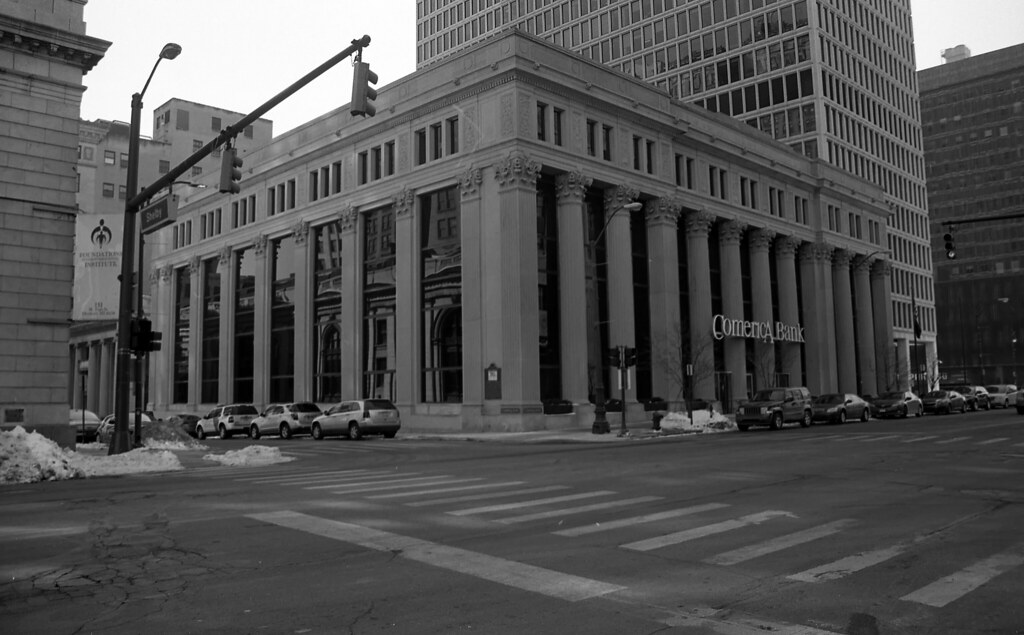There’s nothing left of this fort which is a real shame, but if you consider where it was located, it really would make no sense to maintain a historic fort right in the middle of downtown Detroit, Michigan. But if you care to visit the former site, don’t let the name of the city scare you.

Detroit as it stands today, shot from Windsor, Ontario
For the most part, Fort Detroit has been known over its short life by three names. And while there’s nothing left the fortification was site to the first major engagement during the War of 1812. Initially established to hold the area against the Continental army during the American Revolution, British Officer Captain Richard Lernoult of the 8th (King’s) Regiment of Foot established a fortification in 1779, which became known as Fort Lernoult, a simple wooden palisade and earthwork walls with support buildings inside surrounded by a dry ditch, by October the same year was home to a garrison of 381 troops. British forces continued to occupy the fort until 1796 when they were forced to turn it over to the American Army to comply with the terms of the Jay Treaty. On the 11th of July 1796 Colonel Jean François Hamtrack and 300 US Regulars took possession of the fort.

While the fort is gone, you can still know where it once stood, the intersection of Fort and Shelby, clever Detroit.
When Detroit was incorporated in 1806, Secretary of War, General Henry Dearborn, ordered the Fort’s name be changed to Detroit to match the name of the town that it watched over. When William Hull was appointed as commander of the Michigan Territory he began the expand and improve Fort Detroit’s defenses in light of increased violence from native warriors in the Northwest. The fort served as the launch point for Hull’s short lived invasion and occupation of the western part of Upper Canada, however Detroit soon was the target of General Brock’s siege and was surrendered to the British in August of 1812. The British continued to operate a small garrison in the Fort until September 1813 when General Henry Procter ordered a general retreat from the area ahead of William Henry Harrison’s advance. American troops reoccupied the fort on the 29th of September, Harrison renaming the fortification Fort Shelby after the governor of Kentucky, Isaac Shelby in honour of the state providing so many volunteer militia units.

A plaque marks where one of the fort’s redoubts once stood.
Fort Shelby continued to see occupation even with it falling into a general state of disrepair, and faced with the expanding city of Detroit turned the fort over to the city in 1826, and the fort itself demolished the following year. The Army instead constructed a new limestone and masonry fort further south, closer to the British fort at Amhurstburg (Fort Malden) naming the new fortification Fort Wayne and occupying it by 1851. Fort Wayne continued to see use until 1949. Today there’s nothing more than a historic plaque at Fort and Shelby Street in Detroit. Over 8,000 artifacts from Fort Shelby were recovered in 1961 during the construction of a bank and are now housed in the Wayne University Museum. Fort Wayne was turned over the city of Detroit and was restored and is now open as a living museum.
Written with Files from:
Guidebook to the Historic Sites of the War of 1812 Second Edition by Gilbert Collins – 2006 The Dundurn Group Publishers
Web: www.historicfortwaynecoalition.com
Web: www.eighteentwelve.ca/?q=eng/Topic/14
Photos: Nikon F4 – AF Nikkor 35mm 1:2D – Agfa APX 25 – Kodak Xtol (1+1) 6:00 @ 20C